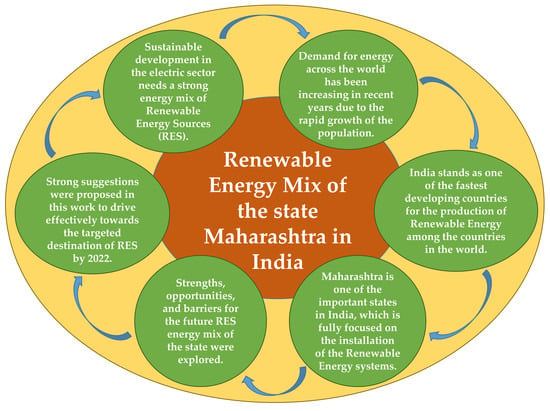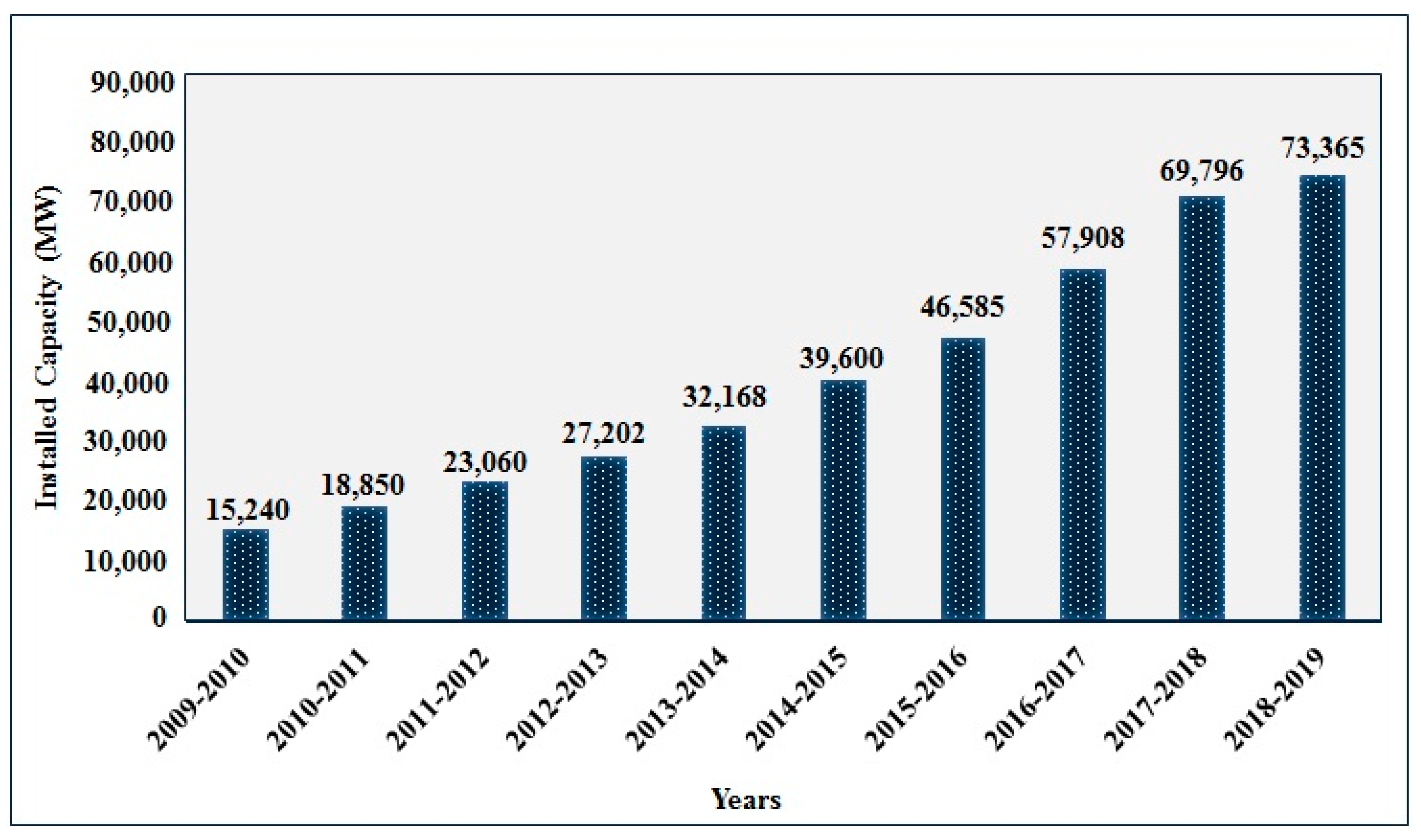A Holistic Review of the Present and Future Drivers of the Renewable Energy Mix in Maharashtra, State of India
Abstract
1. Introduction
- To give an understanding of the renewable energy scenario and performance in Maharashtra in terms of its use of renewable energy resources for the development of the state socially and economically.
- To present research that has been carried out based on India’s renewable energy scenario, policies, and initiatives and examine these studies by discussing their analysis in terms of meeting the needs of the renewable energy system of Maharashtra. A framework is designed for Maharashtra to identify suitable policies, journal publications, and work-related projects.
- To discuss various limitations and barriers and propose unique guidelines for future researchers to overcome the barriers in order to meet the needs of renewable energy resources in the state.
2. Methods for Survey Criteria
- Literature survey on non-conventional energy utilization by various countries;
- Technological advancements and policy schemes of various countries in the literature;
- Non-conventional energy status and technological development in India;
- Renewable energy scenario of Maharashtra: a case study;
- Upcoming green energy projects;
- Analysis of the RES potential of Maharashtra;
- Research outcomes and prospects of Maharashtra.
3. Non-Conventional Energy Utilization by Various Countries
3.1. Research Activities on RES
3.2. Policy Schemes
4. Non-Conventional Energy Status and Technological Development in India
Technological Development in India
5. Renewable Energy Scenario of Maharashtra: A Case Study
- The Maharashtra Electricity Regulatory Commission (MERC) was organized to improve the efficiency and economy of the power sector and to manage the amount of power production, communication, and transportation in order to acknowledge the significance of users and other partners [131].
- Maharashtra State Power Generation Company Limited (MSPGCL) was organized by the Indian Companies Act 1956 following the agreement of the government of Maharashtra to restructure the MSEB [132].
- Maharashtra State Power Transmission Company Limited (MSPTCL) is a fully possessed corporation under the government of Maharashtra that was coordinated by the Companies Act after reorganizing the former MSEB [133].
- Maharashtra State Power Distribution Company Limited (MSPDCL) transmits power to consumers across the state, except in some areas of Mumbai [134].
5.1. Solar Energy
5.1.1. Solar Power Traffic Signals
5.1.2. Solar Heat Generation
5.2. Wind Energy
5.3. Small Hydro
5.4. Biogas
6. Other Potential Alternative Energy Resources
6.1. Geothermal Energy
6.2. Wave Energy
6.3. Tidal Energy
7. Prospective Future Energy Mix of Maharashtra State
7.1. Solar Power for Farming
7.2. Floating Solar Power Projects
8. Exploration of Possible Approaches and Barriers
- Strategic planning can be done with information provided by the authorities;
- It helps in identifying the core competencies of the nation in the renewable sector;
- Opportunities can be maximized according to the response;
- The nation’s strength can be built through its renewable energy process.
8.1. Strengths and Opportunities
8.1.1. Central Government Initiatives
8.1.2. Geography
8.1.3. Solar Mission
8.1.4. Job Opportunities
8.1.5. Policy Implications
8.2. Barriers and Their Significance
8.2.1. Social Barriers
8.2.2. Technical Barriers
8.2.3. Auxiliary Barriers
8.2.4. Institutional Barriers
8.2.5. Technological Barriers
8.2.6. Subsidy Barriers
8.2.7. Political Concerns
8.2.8. Economic Crisis
8.2.9. Lack of Awareness
9. Recommendations and Suggestions
9.1. Formulation of New State RE Policy
9.2. Using Advanced Optimization Tools
9.3. RES-Based Rural Electricity Service
9.4. Better Financial Provision and Incentives
- ⮚
- Interest waivers on loans offered for RES-based projects;
- ⮚
- Increased margin of incentives;
- ⮚
- Directions for rural people in terms of the finance, commission, and operation of RES projects.
9.5. Standardization
9.6. Support from Private Agency
9.7. Recommendations for Researchers
9.8. Schemes for Agriculture Consumers
9.9. Evacuation Infrastructure
10. Conclusions
Author Contributions
Funding
Acknowledgments
Conflicts of Interest
References
- Sinsel, S.R.; Riemke, R.L.; Hoffmann, V.H. Challenges and solution technologies for the integration of variable renewable energy sources-a review. Renew. Energy 2020, 145, 2271–2285. [Google Scholar] [CrossRef]
- Gielen, D.; Boshell, F.; Saygin, D.; Bazilian, M.D.; Wagner, N.; Gorini, R. The role of renewable energy in the global energy transformation. Energy Strateg. Rev. 2019, 11, 38–50. [Google Scholar]
- IRENA and International Energy Agency (IEA). Perspectives for the Energy Transition. Available online: http://www.irena.org/DocumentDownloads/Publications/Perspectives_for_the_Energy_Transition_2017.pdf (accessed on 12 January 2020).
- IEA & the World Bank. Sustainable Energy for All-Progress toward Sustainable Energy; The World Bank & Paris; OECD/IEA: Washington, DC, USA, 2017; Available online: https://www.worldbank.org/content/dam/Worldbank/Event/Energy%20and%20Extractives/Progress%20Toward%20Sustainable%20Energy%20-%20Global%20Tracking%20Framework%202015%20-%20Summary%20Report.pdf (accessed on 20 May 2020).
- Ministry of Energy and Mineral Resources (MEMR). Available online: https://www.memr.gov.jo/echobusv3.0/SystemAssets/56dcb683-2146-4dfd-8a15-b0ce6904f501.pdf (accessed on 12 January 2020).
- Santika, W.G.; Anisuzzaman, M.; Bahri, P.A.; Shafiullah, G.M.; Rupf, G.V.; Urmee, T. From goals tor joules: A quantitative approach of interlinkages between energy and the sustainable development goals. Energy Res. Soc. Sci. 2019, 50, 201–214. [Google Scholar] [CrossRef]
- Markard, J.; Raven, R.; Truffer, B. Sustainability transitions: An emerging field of research and its prospects. Res. Policy 2012, 41, 955–967. [Google Scholar] [CrossRef]
- Tripathi, L.; Mishra, A.K.; Kumar Dubey, A.; Tripathi, C.B.; Baredar, P. Renewable energy: An overview on its contribution in current energy scenario of India. Renew. Sustain. Energy Rev. 2016, 60, 226–233. [Google Scholar] [CrossRef]
- IEA. Renewables Information 2014; International Energy Agency (IEA): Paris, France, 2014; Available online: https://www.iea.org/ (accessed on 20 May 2020).
- Kim, K.; Park, H.; Kim, H. Real options analysis for renewable energy investment decisions in developing countries. Renew. Sustain. Energy Rev. 2017, 75, 918–926. [Google Scholar] [CrossRef]
- Schneider, U.A.; McCarl, B.A. Economic potential of biomass based fuels for greenhouse gas emission mitigation. Environ. Resour. Econ. 2003, 24, 291–312. [Google Scholar] [CrossRef]
- Dowaki, K.; Mori, S. Biomass energy used in a saw mill. Appl. Energy 2005, 80, 327–339. [Google Scholar] [CrossRef]
- Cicea, C.; Marinescu, C.; Popa, I.; Dobrin, C. Environmental efficiency of investments in renewable energy: Comparative analysis at macroeconomic level. Renew. Sustain. Energy Rev. 2014, 30, 555–564. [Google Scholar] [CrossRef]
- Chien, T.; Hu, J.L. Renewable energy and macroeconomic efficiency of OECD and non-OECD economies. Energy Policy 2007, 35, 3606–3615. [Google Scholar] [CrossRef]
- Halkos, G.E.; Tzeremes, N.G. Analyzing the Greek renewable energy sector: A data envelopment analysis approach. Renew. Sustain. Energy Rev. 2012, 16, 2884–2893. [Google Scholar] [CrossRef]
- Aslani, A.; Antila, E.; Wong, K.F.V. Comparative analysis of energy security in the Nordic countries: The role of renewable energy resources in diversification. J. Renew. Sustain. Energy 2012, 4, 1–12. [Google Scholar] [CrossRef]
- Aslani, A.; Naaranoja, M.; Wong, K.F.V. Strategic analysis of diffusion of renewable energy in the Nordic countries. Renew. Sustain. Energy Rev. 2013, 22, 497–505. [Google Scholar] [CrossRef]
- European Commission. EU Budget: Commission Proposes Increased Funding to Invest in Connecting Europeans with High-Performance Infrastructure. Available online: http://europa.eu/rapid/press-release_IP18-4029_en.htm. (accessed on 12 January 2020).
- Simon, F. EU Strikes Early Morning Deal on Energy Governance Bill, Erective. Available online: https://www.euractiv.com/section/energy/news/eu-strikes-early-morning-deal-on-energy-governance-bill/ (accessed on 12 January 2020).
- Athienitis, A.K.; Barone, G.; Buonomano, G.; Palombo, A. Assessing active and passive effects of façade building integrated photovoltaics/thermal systems: Dynamic modelling and simulation. Appl. Energy 2018, 209, 355–382. [Google Scholar] [CrossRef]
- Huang, J.; Chan, X.; Yang, H.; Zhang, W. Numerical investigation of a novel vacuum photovoltaic curtain wall and integrated optimization of photovoltaic envelope systems. Appl. Energy 2018, 229, 1048–1060. [Google Scholar] [CrossRef]
- Rajvikram, M.; Afridhis, S.; Raghavendra Rajan, V.; Umashankar, S.; Nurunnabi, M. SWOT analysis: A framework for comprehensive evaluation of drivers and barriers for renewable energy development in significant countries. Energy Rep. 2020, 6, 1838–1864. [Google Scholar]
- Ikrama, M.; Zhanga, Q.; Sroufe, R.; Ali Shah, S.Z. Towards a sustainable environment: The nexus between ISO 14001, renewable energy consumption, access to electricity, agriculture and CO2 emissions in SAARC countries. Sustain. Prod. Consum. 2020, 22, 218–230. [Google Scholar] [CrossRef]
- Rajvikram, M.; Shafiullah, G.M.; Manoj Kumar, N.; Sanjeevikumar, P. A State-of-the-Art Review on the Drive of Renewables in Gujarat, State of India: Present Situation, Barriers and Future Initiatives. Energies 2020, 13, 1–30. [Google Scholar]
- Manoj Kumar, N.; Chopra, S.S.; Chand, A.A.; Rajvikram, M.; Shafiullah, G.M. Hybrid Renewable Energy Microgrid for a Residential Community: A Techno-Economic and Environmental Perspective in the Context of the SDG7. Sustainability 2020, 12, 1–30. [Google Scholar]
- Rajvikram, M.; Shafiullah, G.M.; Sanjeevikumar, P.; Manoj Kumar, N.; Annapurna, A.; Ajayragavan, M.V.; Mihet-Popa, L.; Holm-Nielsen, J.B. A Comprehensive Review on Renewable Energy Development, Challenges, and Policies of Leading Indian States with an International Perspective. IEEE Access 2020, 8, 7432–7457. [Google Scholar]
- Jeslin Drusila Nesamalar, J.; Venkatesh, P.; Charles Raja, S. The drive of renewable energy in Tamilnadu: Status, barriers and future prospect. Renew. Sustain. Energy Rev. 2017, 73, 115–124. [Google Scholar] [CrossRef]
- Rajesh, V.K.; Sanjay, D.P. Electricity demand supply analysis: Current status and future prospects for Maharashtra, India. Renew. Sustain. Energy Rev. 2012, 16, 3960–3966. [Google Scholar]
- CFR. Global Climatic Change; Council Foreign Relation (CFR): New York, NY, USA, 2013; Available online: https://www.cfr.org/report/global-climate-change-regime (accessed on 5 May 2019).
- Kanase-Patil, A.B.; Saini, R.P.; Sharma, M.P. Sizing of integrated renewable energy system based on load profile and reliability index for the state of Uttarakhand in India. Renew. Energy 2011, 36, 2809–2821. [Google Scholar] [CrossRef]
- Gupta, A.; Saini, R.P.; Sharma, M.P. Steady-state modelling of hybrid energy system for grid electrification of cluster of villages. Renew. Energy 2010, 35, 520–535. [Google Scholar] [CrossRef]
- Rao, N.; Pachauri, S. Energy access and living standards: Some observation on recent trends. Environ. Res. Lett. 2017, 12, 1–5. [Google Scholar] [CrossRef]
- Ahmed, S.; Mathai, M.V.; Parayil, G. Household electricity access, availability and human well-being: Evidence from India. Energy Policy 2014, 69, 308–315. [Google Scholar] [CrossRef]
- Balachandra, P. Dynamics of rural energy access in India: An assessment. Energy 2011, 36, 5556–5567. [Google Scholar] [CrossRef]
- Aklin, M.; Cheng, C.Y.; Urpelainen, J.; Ganesan, K.; Jain, A. Factors affecting household satisfaction with electricity supply in rural India. Nat. Energy 2016, 1, 161–170. [Google Scholar] [CrossRef]
- Laha, P.; Chakraborty, B.; Alberg Ostergaard, P. Electricity system scenario development of India with import independence in 2030. Renew. Energy 2019, 11, 1–13. [Google Scholar] [CrossRef]
- Bose, A.S.; Sarkar, S. India’s e-reverse auctions (2017–2018) for allocating renewable energy capacity: An evaluation. Renew. Sustain. Energy Rev. 2019, 112, 762–774. [Google Scholar] [CrossRef]
- Guidelines for Village Electrification through Decentralized Distributed Generation (DDG) under Rajiv Gandhi Grameen Vidyutikaran Yojana in the XI Plan. Available online: https://powermin.nic.in/sites/default/files/uploads/Guidelines_for_Village_Electrification_DDG_under_RGGVY.pdf (accessed on 5 May 2020).
- Arunachalam, K.; Pedinti, V.S.; Goel, S. Decentralized distributed generation in India: A review. J. Renew. Sustain. Energy 2016, 8, 1–20. [Google Scholar] [CrossRef]
- IEA. Deploying Renewables: Principles for Effective Policies. Available online: http://www.iea.org/publications/freepublications/publication/DeployingRenewables2008.pdf (accessed on 10 January 2020).
- IEA. Deploying Renewables: Best and Future Policy Practice. Available online: http://www.iea.org/publications/freepublications/publication/Deploying_Renewables2011.pdf (accessed on 10 January 2020).
- Prakash, R.; Bhat, I.K. Energy, economics and environmental impacts of renewable energy systems. Renew. Sustain. Energy Rev. 2009, 13, 2716–2721. [Google Scholar]
- Dudhani, S.; Sinha, A.K.; Inamdar, S.S. Renewable energy sources for peak load demand management in India. Int. J. Electr. Power Energy Syst. 2006, 28, 396–400. [Google Scholar] [CrossRef]
- Suganthi, L.; Williams, A. Renewable energy in India—a modelling study for 2020–2021. Energy Policy 2000, 28, 1095–1109. [Google Scholar] [CrossRef]
- Rajesh Kumar, C.; Majid, M.A. Renewable energy for sustainable development in India: Current status, future prospects, challenges, employment, and investment opportunities. Energy Sustain. Soc. 2020, 2, 1–36. [Google Scholar]
- Kumar, N.; Pa1, N. The existence of barriers and proposed recommendations for the development of renewable energy in Indian perspective. Environ. Dev. Sustain. 2018, 22, 2187–2205. [Google Scholar] [CrossRef]
- Rani, P.; Raj Mishra, A.; Raj Pardasani, K.; Mardani, A.; Liao, H.; Streimikiene, D. A novel VIKOR approach based on entropy and divergence measures of Pythagorean fuzzy sets to evaluate renewable energy technologies in India. J. Clean. Prod. 2019, 238, 1–17. [Google Scholar] [CrossRef]
- Rani, P.; Raj Mishra, A.; Mardani, A.; Cavallaro, F.; Alrasheedi, M.; Alrashidi, A. A novel approach to extended fuzzy TOPSIS based on new divergence measures for renewable energy sources selection. J. Clean. Prod. 2020, 257, 1–17. [Google Scholar] [CrossRef]
- Krishankumar, R.; Raj Mishra, A.; Soundarapandian Ravichandran, K.; Peng, X.; Kazimieras Zavadskas, E.; Cavallaro, F.; Mardani, A. A Group Decision Framework for Renewable Energy Source Selection under Interval-Valued Probabilistic linguistic Term Set. Energies 2020, 13, 986. [Google Scholar] [CrossRef]
- Memduh Eren, B.; Taspinar, N.; Gokmenoglu, K.K. The impact of financial development and economic growth on renewable energy consumption: Empirical analysis of India. Sci. Total Environ. 2019, 663, 189–197. [Google Scholar] [CrossRef]
- Aandarajah, G.; Gambhfir, A. India’s CO2 emission pathways to 2050? Appl. Energy 2014, 131, 68–76. [Google Scholar]
- Solar Potential. Available online: http://mnre.gov.in/file-manager/UserFiles/Solar-Potential-NISE.pdf (accessed on 14 January 2020).
- Akella, A.; Saini, R.; Sharma, M. Social, economical and environmental impacts of renewable energy systems. Renew. Energy 2009, 34, 390–396. [Google Scholar] [CrossRef]
- Liserre, M.; Sauter, T.; Hung, J. Future energy systems: Integrating renewable energy sources into the smart power grid through industrial electronics. IEEE Ind. Electron. Mag. 2009, 4, 18–37. [Google Scholar] [CrossRef]
- Pedro, R. Dynamic Influences of Wind Power on the Power System. Ph.D. Thesis, Orsted Institute, Electric Power Engineering, Technical University of Denmark, Copenhagen, Danmark, 2003. [Google Scholar]
- Shafiulah, G.M. HREI system for subtropical climate in Central Queensland, Australia. Renew. Energy 2016, 96, 1014–1033. [Google Scholar] [CrossRef]
- Reda, F.; Viot, M.; Sipila, K.; Helm, M. Energy assessment of solar cooling thermally driven system configurations. Appl. Energy 2016, 166, 27–43. [Google Scholar] [CrossRef]
- Seme, S.; Stumberger, G.; Pihler, J. Predicting daily distribution of solar irradiation by neural networks. In Proceedings of the International Conference on Renewable Energies and Power Quality (ICREPQ), Madrid, Spain, 15–17 April 2009. [Google Scholar]
- Blenkinsopp, T.; Kirwan, K. Non-conventional energy for rural communities in Maharashtra, India. Energy Policy 2013, 60, 182–187. [Google Scholar] [CrossRef]
- Sen, R.; Bhatacharya, S. Off-grid electricity generation with renewable energy technologies in India. Renew. Energy 2014, 62, 388–398. [Google Scholar] [CrossRef]
- Azadeh, A.; Maghsoudi, A.; Khani, S. An Integrated Artificial Neural Networks approach for predicting global radiation. Energy Convers Manag. 2009, 50, 1497–1505. [Google Scholar] [CrossRef]
- Tahir, Y.; Nadeem, M.F.; Ahmed, A.; Khan, I.A.; Qamar, F. A Review on Hybrid Energy Storage Systems in Microgrids. In Proceedings of the 3rd International Conference on Computing, Mathematics and Engineering Technologies (iCoMET), Sukkur, Pakistan, 29–30 January 2020. [Google Scholar]
- Chauhan, A.; Saini, R. Discrete harmony search based size optimization of integrated non-conventional Energy System for remote rural areas of Utarakhand state in India. Renew. Energy 2016, 94, 578–603. [Google Scholar] [CrossRef]
- Ramesh, M.; Saini, R.P. Dispatch strategies based performance analysis of a hybrid renewable energy system for aremote rural area in India. J. Clean. Prod. 2020, 259. [Google Scholar] [CrossRef]
- Chauhan, A.; Saini, R. Techno-economic feasibility study on integrated non-conventional energy system of India. Renew. Sustain. Energy Rev. 2016, 59, 377–399. [Google Scholar] [CrossRef]
- Rajvikram, M. The Motivation for Renewable Energy and its Comparison with Other Energy Sources: A Review. Eur. J. Sustain. Dev. Res. 2018, 3, 1–19. [Google Scholar]
- Sana, S.; Syed, S. Review of Spanish renewable energy policy to encourage investment in solar photovoltaic. J. Renew. Sustain. Energy 2012, 4, 1–13. [Google Scholar]
- Bebonchu, A.; Chelsea, H. The effect of renewable and non-renewable electricity generation on economic growth. Energy Policy 2018, 112, 111–118. [Google Scholar]
- Rajvikram, M.; Gopinath, C.; Ramkumar, S.; Leoponraj, S. A Novel Methodology of IoT Implementation in Energy Management. Power Res. 2018, 14, 85–91. [Google Scholar] [CrossRef]
- Wesseh, K.; Boqiang, L. Is renewable energy a model for powering Eastern African countries transition to industrialization and urbanization? Renew. Sustain. Energy Rev. 2017, 75, 909–917. [Google Scholar] [CrossRef]
- Taeyoung, J.; Jinsoo, K. What is better for mitigating carbon emissions – Renewable energy or nuclear energy? A panel data analysis. Renew. Sustain. Energy Rev. 2018, 91, 464–471. [Google Scholar]
- Ferda, H.; Natalya, K. Output, renewable and non-renewable energy production, and international trade: Evidence from EU-15 countries. Energy 2018, 159, 995–1002. [Google Scholar]
- Hussain, A.; Ali, M.; Tahira, Y. CO2 emissions, energy consumption, economic growth, and financial development in GCC countries: Dynamic simultaneous equation models. Renew. Sustain. Energy Rev. 2017, 70, 117–132. [Google Scholar]
- Ting, W.; Boqiang, L. Impacts of unconventional gas development on China’s natural gas production and import. Renew. Sustain. Energy Rev. 2014, 39, 546–554. [Google Scholar]
- Tasdemiroglu, E. Salt Availability in Turkey and its Potential Use in Solar Ponds. Resour. Conserv. 1987, 15, 215–228. [Google Scholar] [CrossRef]
- Hui, X.; Gregory, C.; Berna, K.M. Do non-renewable—Energy prices affect renewable—Energy volatility? The case of wood pellets. J. For. Econ. 2017, 28, 42–48. [Google Scholar]
- Kuldeep, H.; Kalpesh, V. Pyramid solar still: A comprehensive review. Renew. Sustain. Energy Rev. 2018, 81, 136–148. [Google Scholar]
- Ahmed, A. Wind energy characteristics and wind park installation in Shark El-Quimet, Egypt. Renew. Sustain. Energy Rev. 2018, 82, 734–742. [Google Scholar] [CrossRef]
- Ellahi, M.; Abbas, G.; Khan, I.A.; Koola, P.M.; Nasir, M.; Raza, A.; Farooq, U. Recent approaches of forecasting and optimal economic dispatch to overcome intermittency of wind and photovoltaic (PV) systems: A review. Energies 2019, 12, 4392. [Google Scholar] [CrossRef]
- Peng, W.; Zeng, Y.; Gong, H.; Leng, Y.Q.; Yan, Y.H.; Hu, W. Evolutionary algorithm and parameters extraction for dye-sensitised solar cells one-diode equivalent circuit model. Micro Nano Lett. 2013, 8, 86–89. [Google Scholar] [CrossRef]
- Vega-Garita, V.; De Lucia, D.; Narayan, N.; Ramirez-Elizondo, L.; Bauer, P. PV-battery integrated module as a solution for off-grid applications in the developing world. In Proceedings of the IEEE International Energy Conference (ENERGYCON), Limassol, Cyprus, 3–7 June 2018. [Google Scholar]
- Ahmed, A.; Faisal Nadeem, M.; Ali Sajjad, I.; Bo, R.; Khan, I.A.; Raza, A. Probabilistic generation model for optimal allocation of wind DG in distribution systems with time varying load models. Sustain. Energy Grids Netw. 2020, 22, 1–12. [Google Scholar] [CrossRef]
- Olumide, O.; Edmund, C. Concentrating solar power technologies for solar thermal grid electricity in Nigeria: A review. Renew. Sustain. Energy Rev. 2018, 90, 104–119. [Google Scholar]
- Khalaji, M.; Bakhoda, S.; Saidur, R.; Hanaei, H. Recent progress in perovskite solar cells. Renew. Sustain. Energy Rev. 2018, 81, 2812–2822. [Google Scholar]
- Manoharan, P.; Umashankar, S.; Sudhakar Babu, T.; Rajvikram, M.; Mihet-Popa, L. Evaluation of Mathematical Model to Characterize the Performance of Conventional and Hybrid PV Array Topologies under Static and Dynamic. Energies 2020, 13, 1–37. [Google Scholar]
- Premkumar, M.; Sowmya, R. An effective maximum power point tracker for partially shaded solar photovoltaic systems. Energy Rep. 2020, 5, 1445–1462. [Google Scholar] [CrossRef]
- Premkumar, M.; Babu, T.S.; Umashankar, S.; Sowmya, R. A New Metaphor-less Algorithms for the Photovoltaic Cell Parameter Estimation. Optik 2020, 208. [Google Scholar] [CrossRef]
- Rajvikram, M.; Aritra, G.; Tapas, K.; Apoorva, K.; Meenal, S. Investigations on Performance Enhancement Measures of the Bidirectional Converter in PV- Wind Interconnected Microgrid System. Energies 2009, 12, 345–350. [Google Scholar]
- Plutshack, V.; Sengupta, S.; Sahayc, A.; Vinnuales, J.E. New and renewable energy social enterprises accessing government support: Findings from India. Energy Policy 2019, 132, 367–378. [Google Scholar] [CrossRef]
- Das, M.; Anil Kumar Singh, M.; Biswas, A. Techno-economic optimization of an off-grid hybrid renewable energy system using metaheuristic optimization approaches—Case of a radio transmitter station in India. Energy Convers. Manag. 2019, 185, 339–352. [Google Scholar] [CrossRef]
- Rajvikram, M.; Velmurugan, K.; Umashankar, S.; Rakesh Kumar, A.; Almakhles, D. Experimental investigations conducted for the characteristic study of OM29 phase change material and its incorporation in photovoltaic panel. Energies 2020, 13, 1–18. [Google Scholar]
- Rajvikram, M.; Leoponraj, S.; Ramkumar, S.; Akshaya, H.; Dheeraj, A. Experimental investigation on the abasement of operating temperature in solar photovoltaic panel using PCM and aluminum. Sol. Energy 2019, 188, 327–338. [Google Scholar]
- Rajvikram, M.; Sivasankar, G. Experiment study conducted for the identification of best heat absorption and dissipation methodology in solar photovoltaic panel. Sol. Energy 2019, 193, 283–292. [Google Scholar] [CrossRef]
- Shanmugam, N.; Pugazhendhi, R.; Rajvikram, M.; Kasiviswanathan, P.; Das, N. Anti-Reflective Coating Materials: A Holistic Review from PV Perspective. Energies 2020, 13, 2631. [Google Scholar] [CrossRef]
- Rajvikram, M.; Leoponraj, S. A method to attain power optimality and efficiency in solar panel. Beni-Suef Univ. J. Basic Appl. Sci. 2018, 4, 705–708. [Google Scholar] [CrossRef]
- Rajvikram, M.; Leoponraj, S.; Rajkumar, S. Enhancement of solar panel efficiency with the adoption of anti reflective coating techniques. J. Sci. Ind. Res. 2020, 79, 261–265. [Google Scholar]
- Dong, L.; Ren, J. Spatial distribution of China ׳s non-conventional energy industry. Renew. Sustain. Energy Rev. 2016, 58, 1511–1521. [Google Scholar]
- Zhao, Z.; Chang, R. How to stimulate non-conventional energy power generation effectively? Renew. Energy 2016, 92, 147–156. [Google Scholar] [CrossRef]
- Saxena, R.; Adhikari, D.; Goyal, H. Biomass based energy fuel through biochemical routes: A review. Renew. Sustain. Energy Rev. 2009, 13, 167–178. [Google Scholar] [CrossRef]
- Asalani, A.; Wong, K. Strategic analysis of diffusion of non-conventional energy in the Nordic countries. Renew. Sustain. Energy Rev. 2013, 22, 495–503. [Google Scholar]
- Engalken, M.; Wepe, I. Comparing drivers, barriers, and opportunities of business models for non-conventional energies: A review. Renew. Sustain. Energy Rev. 2016, 60, 785–801. [Google Scholar]
- Gabriel, C.; Kirkwood, J. Lessons from non-conventional energy entrepreneurs in developing countries. Energy Policy 2016, 95, 326–339. [Google Scholar] [CrossRef]
- Ahsan, N. Solid waste management plan for Indian mega cities. Indian J. Env. Prot. 1999, 2, 90–95. [Google Scholar]
- Bansal, N.; Srivastava, V.K.; Kheraluwala, J. Renewable Energy in India: Policies to Reduce Greenhouse Gas Emissions. Greenh. Gas Emiss. Energy Environ. Sustain. 2019, 161–178. [Google Scholar] [CrossRef]
- Connolly, D.; Matiesen, B. Smart energy Europe: The technical and economic impact of one potential 100% non-conventional energy scenario. Renew. Sustain. Energy Rev. 2016, 60, 1524–1533. [Google Scholar] [CrossRef]
- Alonso, P.; Guilén, J.; Bresers, H. Losing the roadmap: Non-conventional energy paralysis in Spain. Renew. Energy 2016, 89, 670–684. [Google Scholar] [CrossRef]
- Galego, C.; Victoria, M. Cost-free feed-in tariffs for non-conventional energy deployment in Spain. Renew. Energy 2015, 81, 401–410. [Google Scholar]
- Khan, I.; Xu, Y.; Kar, S.; Chow, M.Y.; Bhattacharjee, V. Compressive Sensing and Morphology Singular Entropy-Based Real-Time Secondary Voltage Control of Multiarea Power Systems. IEEE Trans. Ind. Inform. 2018, 15, 3796–3807. [Google Scholar] [CrossRef]
- Haas, R.; Reach, G.; Rawitz, M. Efficiency and effectiveness of promotion systems for electricity generation from non-conventional energy sources. Energy 2011, 36, 2176–2183. [Google Scholar] [CrossRef]
- Anwar, J.; Ahmed, S.; Haslenda, H.; Habib, A.; Ramli, M. Economic and environ- mental benefits of landfill gas from municipal solid waste in Malaysia. Renew. Sustain. Energy Rev. 2012, 16, 2907–2912. [Google Scholar]
- Zainura, N.; Rafiu, Y.; Ahmad, A.; Mohd, H.; Mohd, F. An overview for energy recovery from municipal solid waste (MSW) in Malaysia scenario. Renew. Sustain. Energy Rev. 2013, 20, 378–384. [Google Scholar]
- Shelev, S.; Van, J. Optimal diversity of non-conventional energy alternatives under multiple criteria. Renew. Sustain. Energy Rev. 2016, 60, 659–671. [Google Scholar]
- Freaw, B.; Jakobson, M. Flexibility mechanisms and pathways to a highly non-conventional US electricity future. Energy 2016, 101, 45–58. [Google Scholar]
- Genzer, E.; Agrawal, R. A commentary on the US policies for efficient large scale non-conventional energy storage systems. Energy Policy 2016, 88, 457–464. [Google Scholar]
- Kumar, S.; Malener, R. CO2 emission reduction potential assessment using non-conventional energy in India. Energy 2016, 97, 263–272. [Google Scholar] [CrossRef]
- Chadel, S.; Srivastva, R.; Sharma, V.; Ramsamy, P. Overview of the initiatives in non-conventional energy sector under the national action plan on climate change in India. Renew. Sustain. Energy Rev. 2016, 54, 866–873. [Google Scholar] [CrossRef]
- Rajvikram, M. Comprehensive Review on India’s Growth in Renewable Energy Technologies in Comparison with Other Prominent Renewable Energy Based Countries. J. Sol. Energy Eng. 2020, 142, 03801–03811. [Google Scholar]
- Panar, N.; Kauzhik, S. Role of non-conventional energy sources in environmental protection: A review. Renew. Sustain. Energy Rev. 2011, 15, 1503–1514. [Google Scholar]
- Christopher, J.; Koroneos, G.; Nanaki, E. Integrated solid waste management and energy production—A lifecycle assessment approach: The case study of the city of Thessaloniki. J. Clean Prod. 2012, 27, 141–150. [Google Scholar]
- Global Renewable Eenergy. Available online: https://www.weforum.org/agenda/2018/02/countrie-behind-global-renewaable-energy-growth/ (accessed on 4 May 2020).
- Ministry of New and Renewable Energy Annual Reports. Available online: https://mnre.gov.in/annual-report (accessed on 20 May 2020).
- India Brand Equity Foundation Renewable Energy in India Report. Available online: https://www.ibef.org/industry/renewable-energy.aspx (accessed on 20 May 2020).
- Behuria, P. The politics of late late development in renewable energy sectors: Dependency and contradictory tensions in India’s National Solar Mission. World Dev. 2020, 126, 1–12. [Google Scholar] [CrossRef]
- Generating Heat Water Through Solar. Available online: https://mnre.gov.in/file-manager/UserFiles/Sun-Focus_October-December-2016.pdf (accessed on 18 January 2020).
- Bayrak, F.; Oztop, H.F.; Selimefendigil, F. Effects of different fin parameters on temperature and efficiency for cooling of photovoltaic panels under natural convection. Sol. Energy 2019, 188, 484–494. [Google Scholar] [CrossRef]
- Ravindra, K.; Visscher, A.; Dahiya, R.; Chandra, A. Municipal solid waste characterization and its assessment for potential methane generation: A case study. J. Sci. Total Environ. 2006, 1, 1–10. [Google Scholar]
- Rajvikram, M. Solutions for voltage SAG in a doubly fed induction generator based wind turbine: A review. Power Res. 2018, 14, 73–77. [Google Scholar] [CrossRef]
- Rajvikram, M.; Renuga, P.; Kumar, G.A.; Bavithra, K. Fault ride-through capability of Permanent Magnet Synchronous Generator based Wind Energy Conversion System. Power Res. 2016, 12, 531–538. [Google Scholar]
- Rajvikram, M.; Renuga, P.; Swathisriranjani, M. Fuzzy Based MPPT Controller’s Role in Extraction of Maximum Power in Wind Energy Conversion System. In Proceedings of the International Conference on Control, Instrumentation, Communication and Computational Technologies (ICCICCT), Kumaracoil, India, 16–17 December 2016. [Google Scholar]
- Power supply of Maharashtra. Available online: http://greencleanguide.com/power-supply-position-of-the-state-of-maharashtra/ (accessed on 14 May 2020).
- Mercindia. Available online: http://www.mercindia.org.in/Aboutus.html (accessed on 20 May 2020).
- Mahagenco-Solar. Available online: https://www.projectstoday.com/News/MAHAGENCO-may-shift-Sakri-solar-plant-project-to-Vidarbha (accessed on 14 May 2020).
- Mahatransco. Available online: https://www.mahatransco.in/ (accessed on 24 May 2020).
- Mahadiscom. Available online: https://www.mahadiscom.in/msedcl-profile/ (accessed on 24 May 2020).
- Mahagenco. Available online: https://www.mahagenco.in/index.php/about-us/articles (accessed on 20 May 2018).
- Power Scenario. Available online: http://www.theelectricalguy.in/power-scenario-in-maharashtra-in-detail/ (accessed on 24 May 2020).
- Ministry of New and Renewable Energy Resources (MNRE)-Solar Parks. Available online: https://mnre.gov.in/img/documents/uploads/bcf7e95e88ae4f8dbfa8bd25d21e5e12.pdf (accessed on 1 May 2020).
- Solar Power Traffic Signals. Available online: https://www.mahaurja.com/meda/special_projects/solar_power_traffic_signals (accessed on 1 June 2018).
- Solar Process Heat Generation. Available online: https://www.mahaurja.com/meda/special_projects/solar_process_heat_generation (accessed on 1 May 2020).
- Access for Maharashtra RES. Available online: https://en.wikipedia.org/wiki/Maharashtra (accessed on 5 May 2020).
- Zerouali, M.; Boutouba, M.; Ougli, A.; Tidhaf, B. Control of variable speed wind energy conversion systems by fuzzy logic and conventional P&O. In Proceedings of the International Conference on Intelligent Systems and Advanced Computing Sciences (ISACS), Taza, Morocco, 26–27 December 2019. [Google Scholar]
- Mohseni, M.; Islam, S.M.; Masoum, M.A.S. Impacts of Symmetrical and Asymmetrical Voltage Sags on DFIG-Based Wind Turbines Considering Phase-Angle Jump, Voltage Recovery, and Sag Parameters. IEEE Trans. Power Electron. 2011, 26, 1587–1598. [Google Scholar] [CrossRef]
- Vankusawade Wind Power Plant. Available online: https://www.thewindpower.net/windfarm_en_3330_vankusawade-wind-park.php (accessed on 14 May 2020).
- Data System of India. Available online: http://www.india-wris.nrsc.gov.in/wrpinfo/index.php?title=Main_Page (accessed on 20 May 2020).
- Wind Power Technologies. Available online: https://www.mahaurja.com/meda/grid_connected_power/wind_power/wind_power_technologies (accessed on 20 May 2020).
- Mercindia. Available online: www.mercindia.org (accessed on 24 May 2020).
- Mahaurja. Available online: www.mahaurja.com (accessed on 24 May 2020).
- Waste to Energy Mangement. Available online: https://www.mahaurja.com/meda/grid_connected_power/waste_to_energy (accessed on 4 May 2020).
- Wind Energy State Policy. Available online: https://www.mahaurja.com/meda/grid_connected_power/wind_power/state_policy (accessed on 25 May 2020).
- Solar Power Project. Available online: https://www.mahaurja.com/meda/en/grid_connected_power/solar_power (accessed on 25 May 2020).
- Solar Energy State Policy. Available online: https://www.mahaurja.com/meda/grid_connected_power/solar_power/state_policy (accessed on 25 May 2020).
- Biomass Energy State Policy. Available online: https://www.mahaurja.com/meda/grid_connected_power/biomass/state_policy (accessed on 25 May 2020).
- Small Hydro Power State Policy. Available online: https://www.mahaurja.com/meda/grid_connected_power/small_hydro/state_policy (accessed on 5 May 2020).
- Geothermal Power. Available online: https://www.mahaurja.com/meda/new_technologies/geothermal_power (accessed on 8 May 2020).
- Wave Power. Available online: https://www.mahaurja.com/meda/new_technologies/wave_power (accessed on 16 May 2020).
- Tidal Power. Available online: https://www.mahaurja.com/meda/new_technologies/tidal_power (accessed on 24 January 2020).
- Farmlands with Solar Power. Available online: https://energy.economictimes.indiatimes.com/news/renewable/maharashtra-launches-project-to-connect-farmlands-with-solar-power/61512924 (accessed on 14 May 2020).
- Floating Solar Power Project. Available online: https://energy.economictimes.indiatimes.com/news/renewable/floating-solar-power-projects-maha-mulling-swiss-challenge-method/64535270 (accessed on 18 May 2020).
- Solar Installation on Ujani Dam. Available online: https://mercomindia.com/maharashtra-study-floating-solar-ujani-dam/ (accessed on 4 May 2020).
- Rathi, R.; Prakash, C.; Singh, S.; Krolczyk, G.; Pruncu, C.I. Measurement and analysis of wind energy potential using fuzzy based hybrid MADM approach. Energy Rep. 2020, 6, 228–237. [Google Scholar] [CrossRef]
- Chen, W.; Zhang, L. Experimental investigations on the quaternary in- terdiffusion coefficients, Young’s modulus and hardness in bcc Ti-Nb-Ta-Zr quaternary alloys. J. Phase Equilib. Diffus. 2019, 40, 1–10. [Google Scholar] [CrossRef]
- Fetanat, A.; Khorasaninejad, E.J.O. A novel hybrid MCDM approach for offshore wind farm site selection: A case study of Iran. Ocean Coast. Manag. 2019, 109, 17–28. [Google Scholar] [CrossRef]
- Rahman, O.; Muttaqi, K.M.; Sutanto, D. High Temperature Superconducting Devices and Renewable Energy Resources in Future Power Grids: A Case Study. IEEE Trans. Appl. Supercond. 2019, 29, 404–407. [Google Scholar] [CrossRef]
- Solar Thermal Policy. Available online: https://www.mahauja.com/meda/data/off_grid_solar/RE%20Solar%20Policies%20and%20GRs/Central%20Policy/Solar%20Thermal.pdf (accessed on 4 March 2020).
- Wind Power Policy. Available online: https://www.mahaurja.com/meda/data/off_grid_wind_power/Telecom%20Tower%20Policy.pdf (accessed on 14 April 2020).
- Wind Power State Policy. Available online: https://www.mahaurja.com/meda/data/grid_wind_power/state_policy/Policy%202015_2.pdf (accessed on 14 April 2020).
- Waste to Energy Policy. Available online: https://www.mahaurja.com/meda/data/off_grid_waste_to_energy/Waste%20to%20Energy%20-%20State%20policy.pdf (accessed on 14 May 2020).
- Mohammed, Y.; Mokhtar, A.; Bashir, N.; Saidur, R. An overview of agricultural biomass for decentralized rural energy in Ghana. Renew Sustain. Energy Rev. 2013, 20, 15–22. [Google Scholar] [CrossRef]
- Shahsavari, A.; Akbari, M. Potential of solar energy in developing countries for reducing energy-related emissions. Renew. Sustain. Energy Rev. 2018, 90, 275–291. [Google Scholar] [CrossRef]
- Lupangu, C.; Bansal, R.C. A review of technical issues on the development of solar photovoltaic systems. Renew. Sustain. Energy Rev. 2017, 73, 950–965. [Google Scholar] [CrossRef]
- Jain, S.; Jain, N.K.; Vaughn, W.J. Challenges in meeting all of India’s electricity from solar: An energetic approach. Renew. Sustain. Energy Rev. 2018, 82, 1006–1013. [Google Scholar] [CrossRef]
- Raina, G.; Sinha, S. Outlook on the Indian scenario of solar energy strategies: Policies and challenges. Energy Strateg. Rev. 2019, 24, 331–341. [Google Scholar] [CrossRef]
- Political and Institutional Barriers. Available online: http://www.idfc.com/pdf/publications/Discusion-paper-on-Renewable-Energy.pdf (accessed on 4 February 2020).
- Krishnamoorthy, R.; Udhayakumar, K.; Kannadasan, R.; Rajvikram, M.; Mihet-Popa, L. An Assessment of Onshore and Offshore Wind Energy Potential in India Using Moth Flame Optimization. Energies 2020, 13, 3063. [Google Scholar]
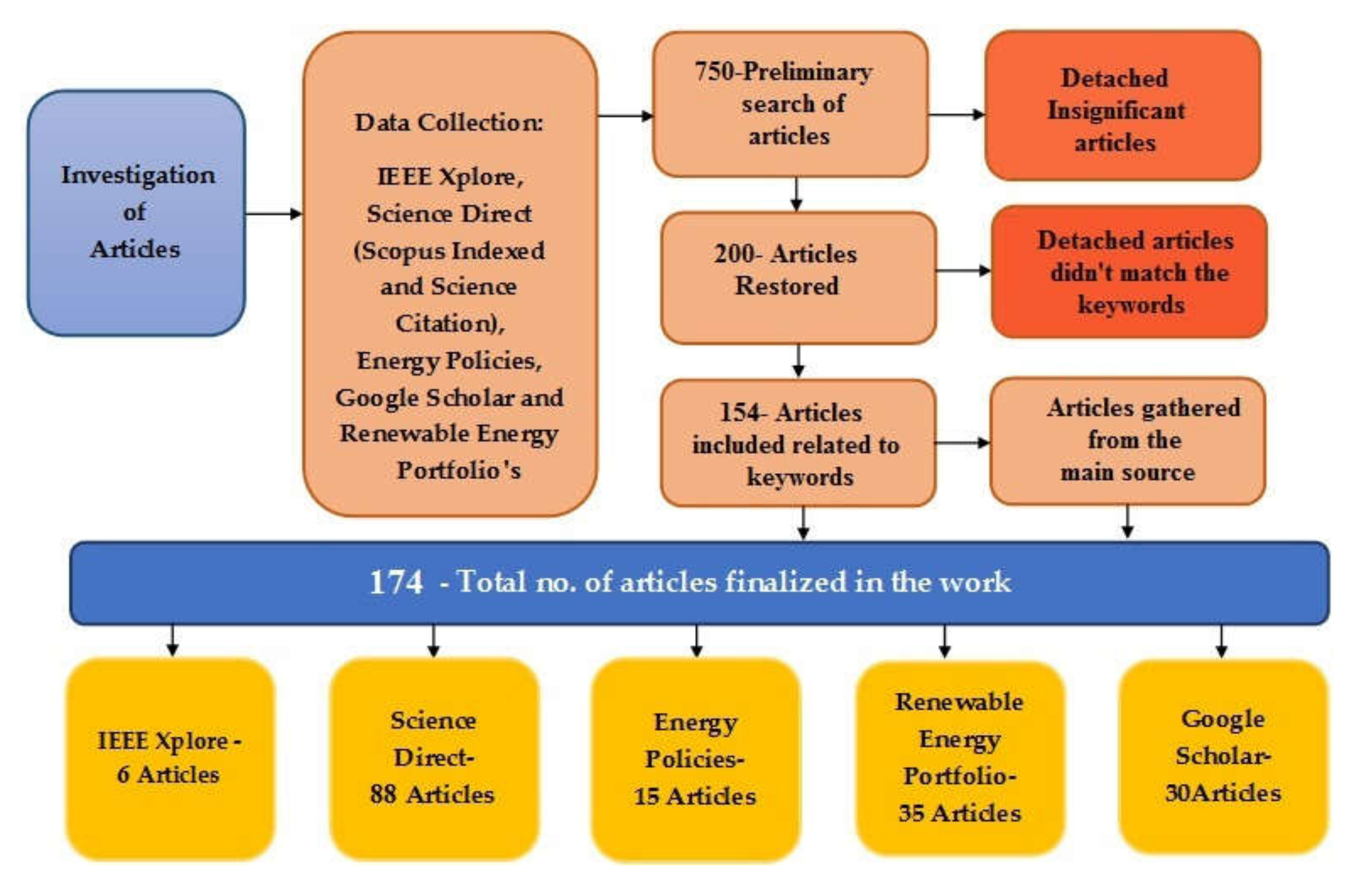
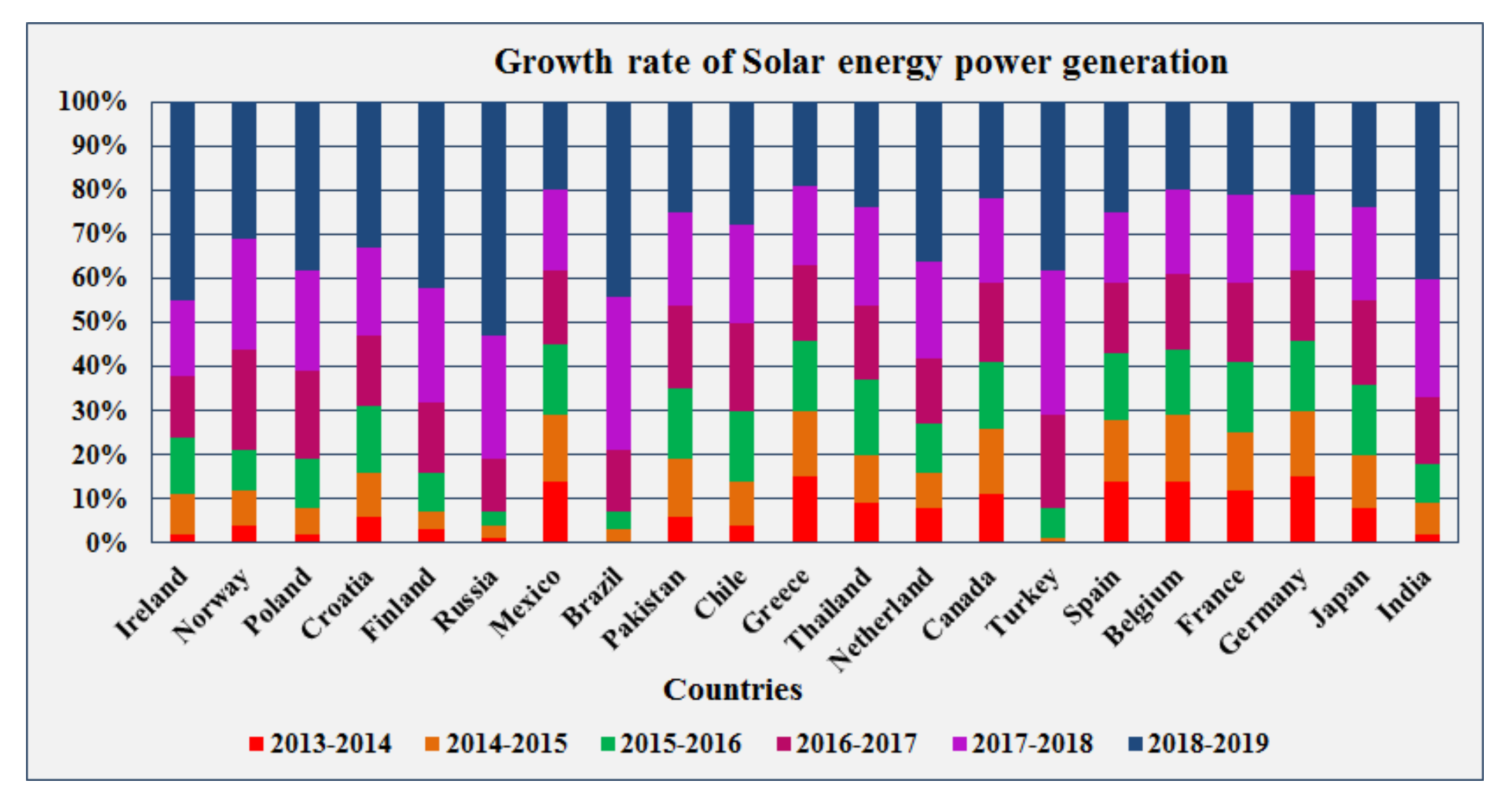
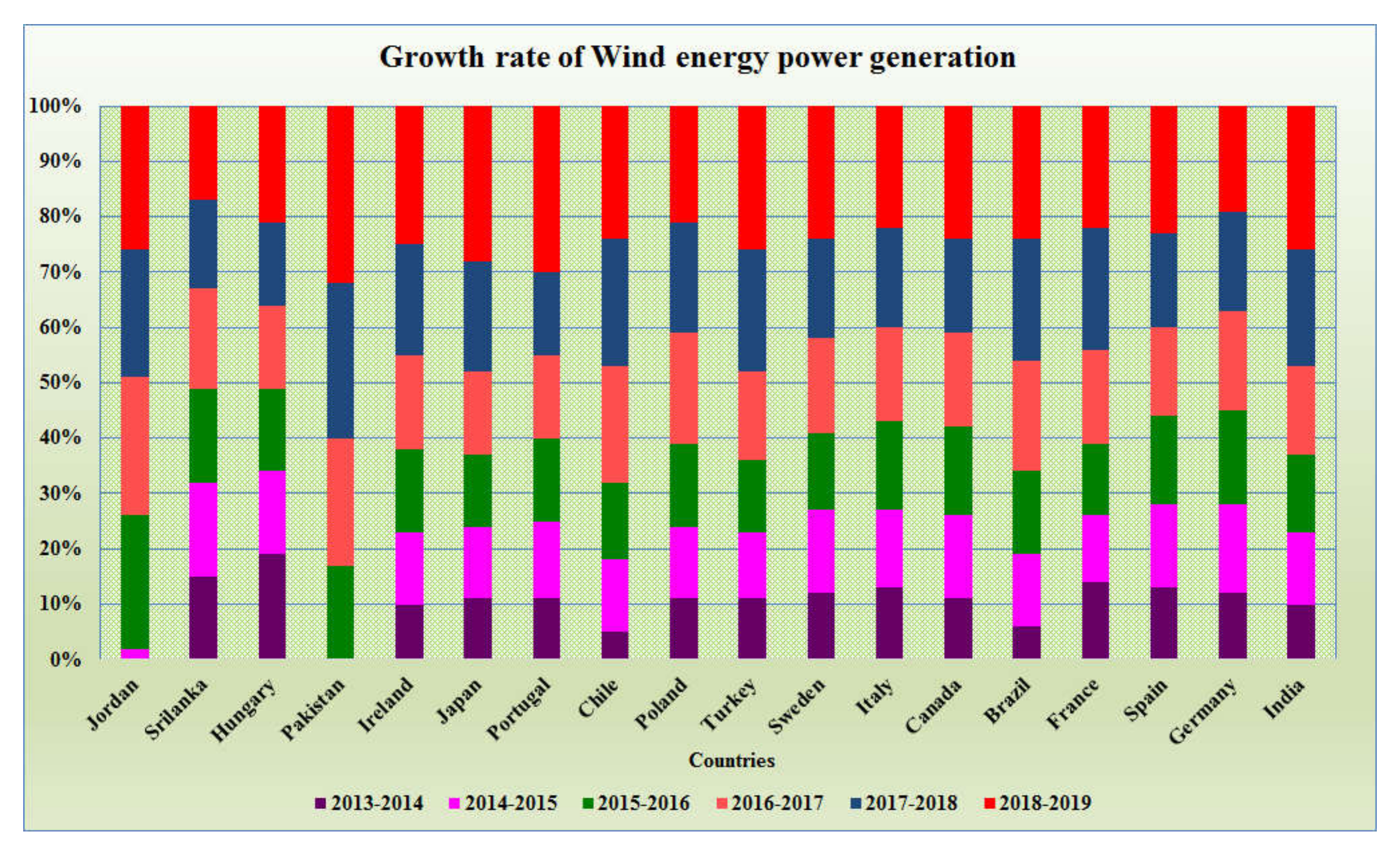
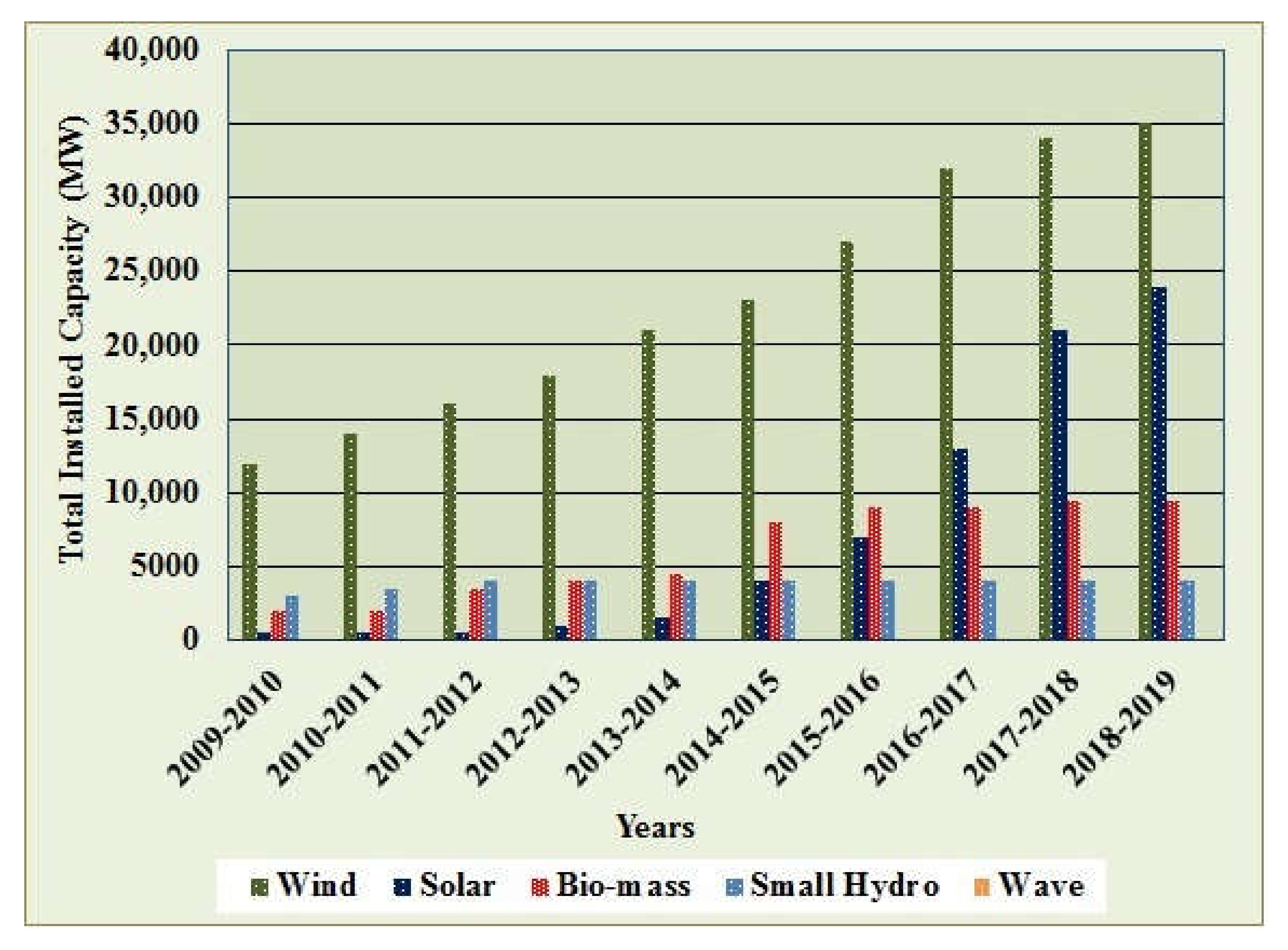
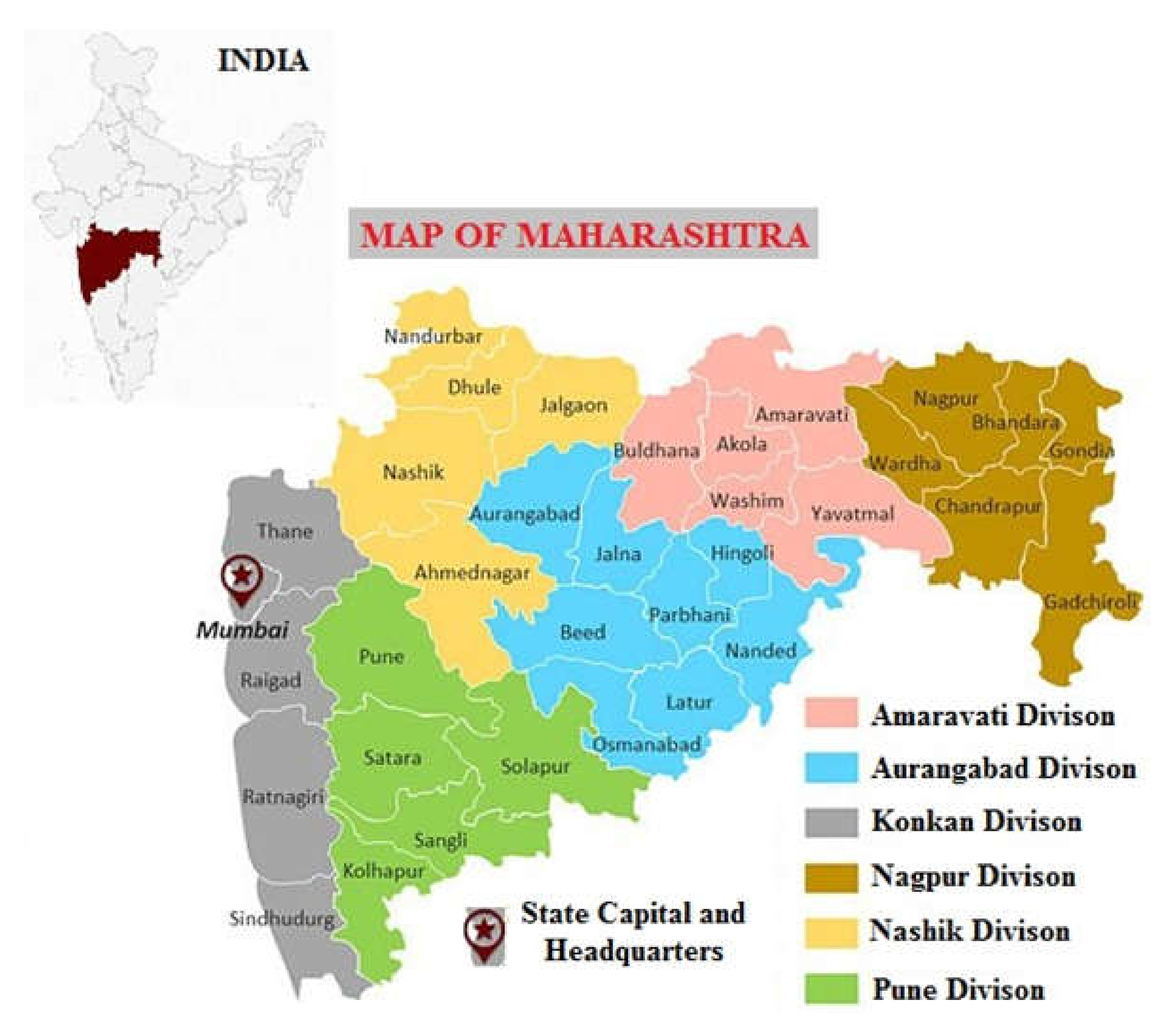
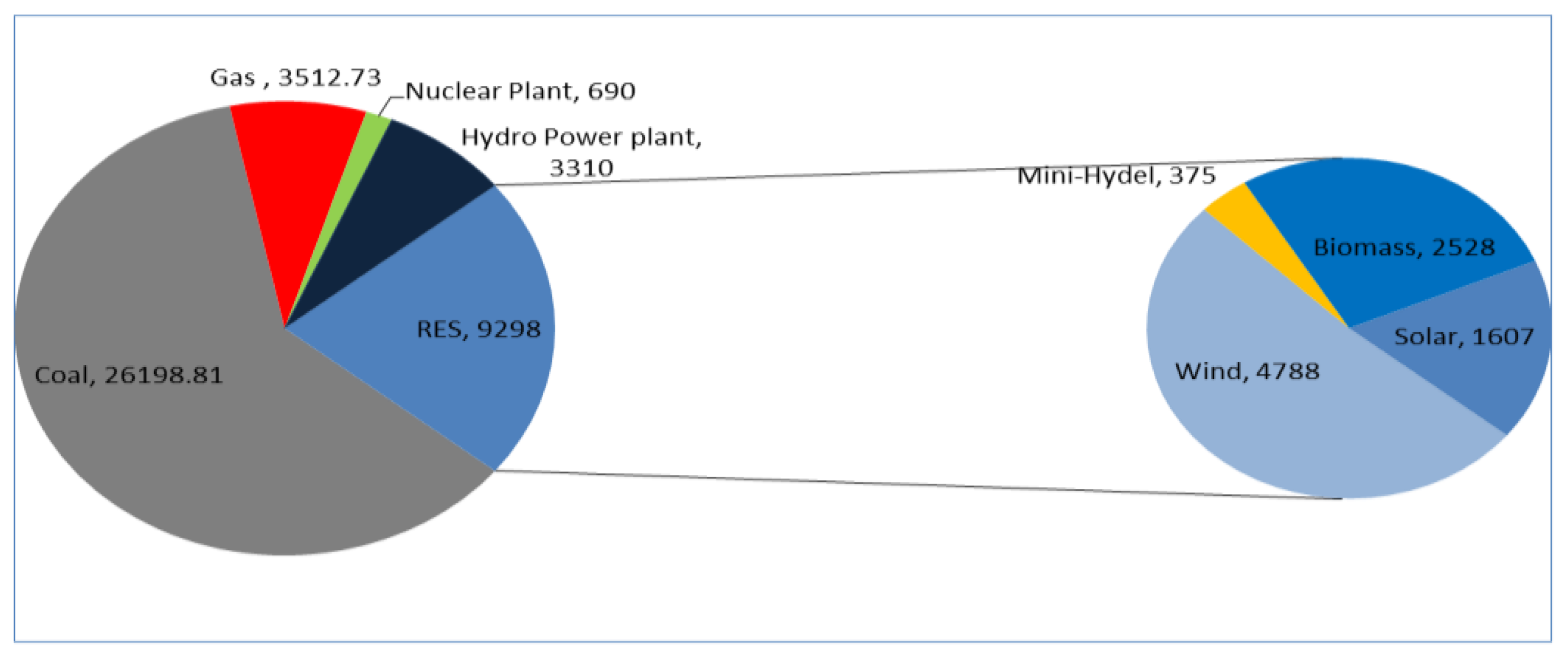

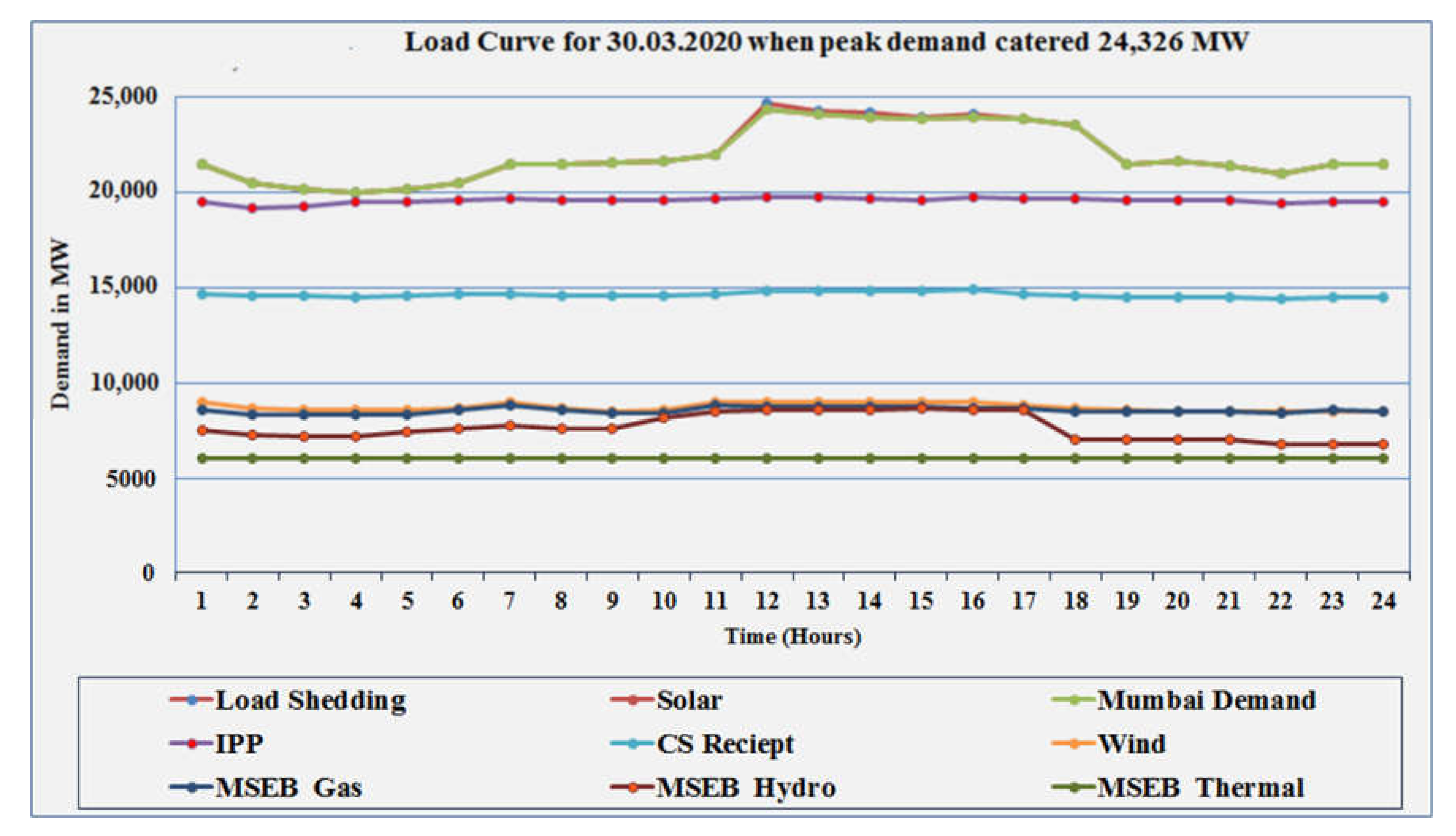
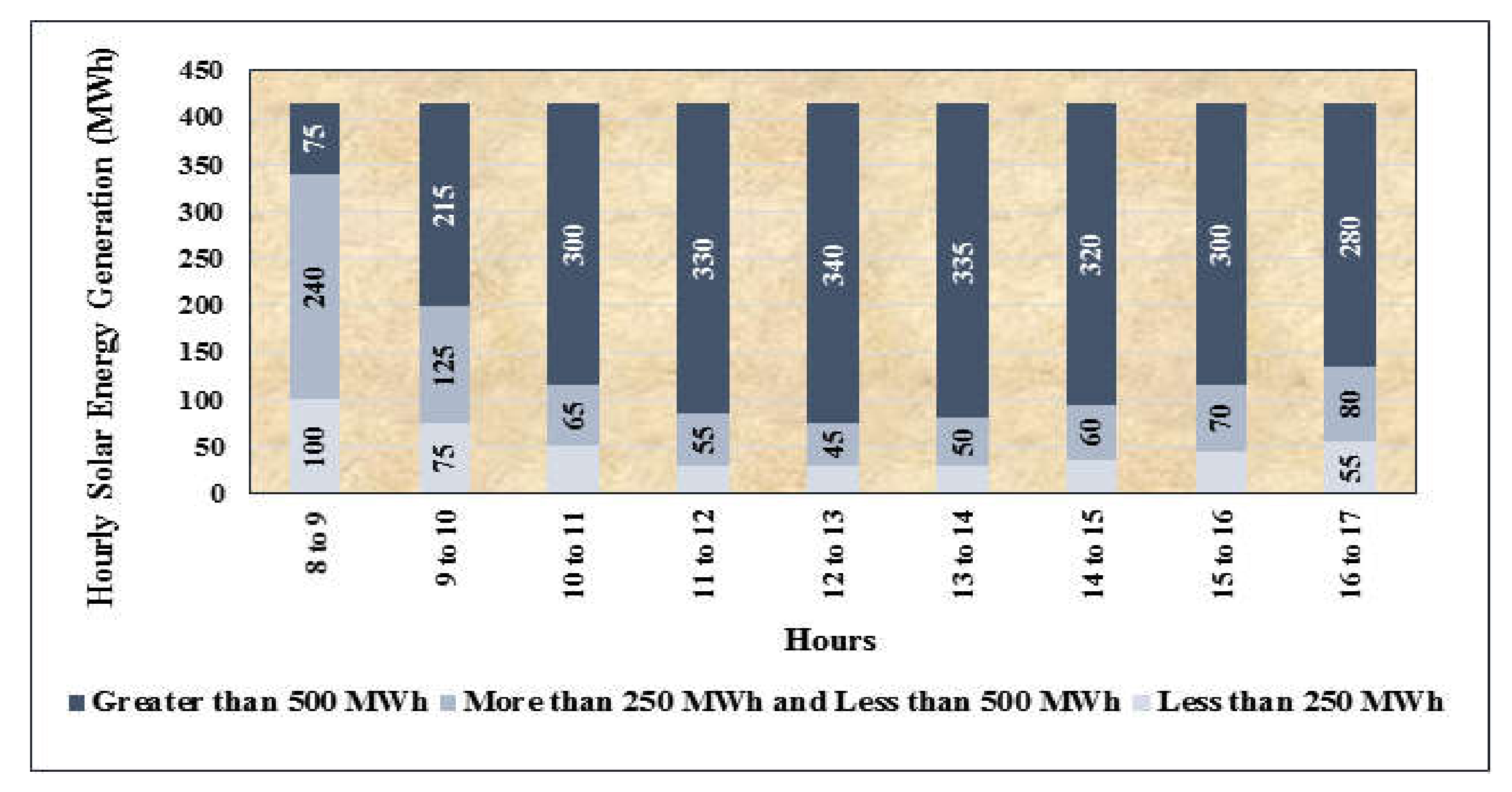
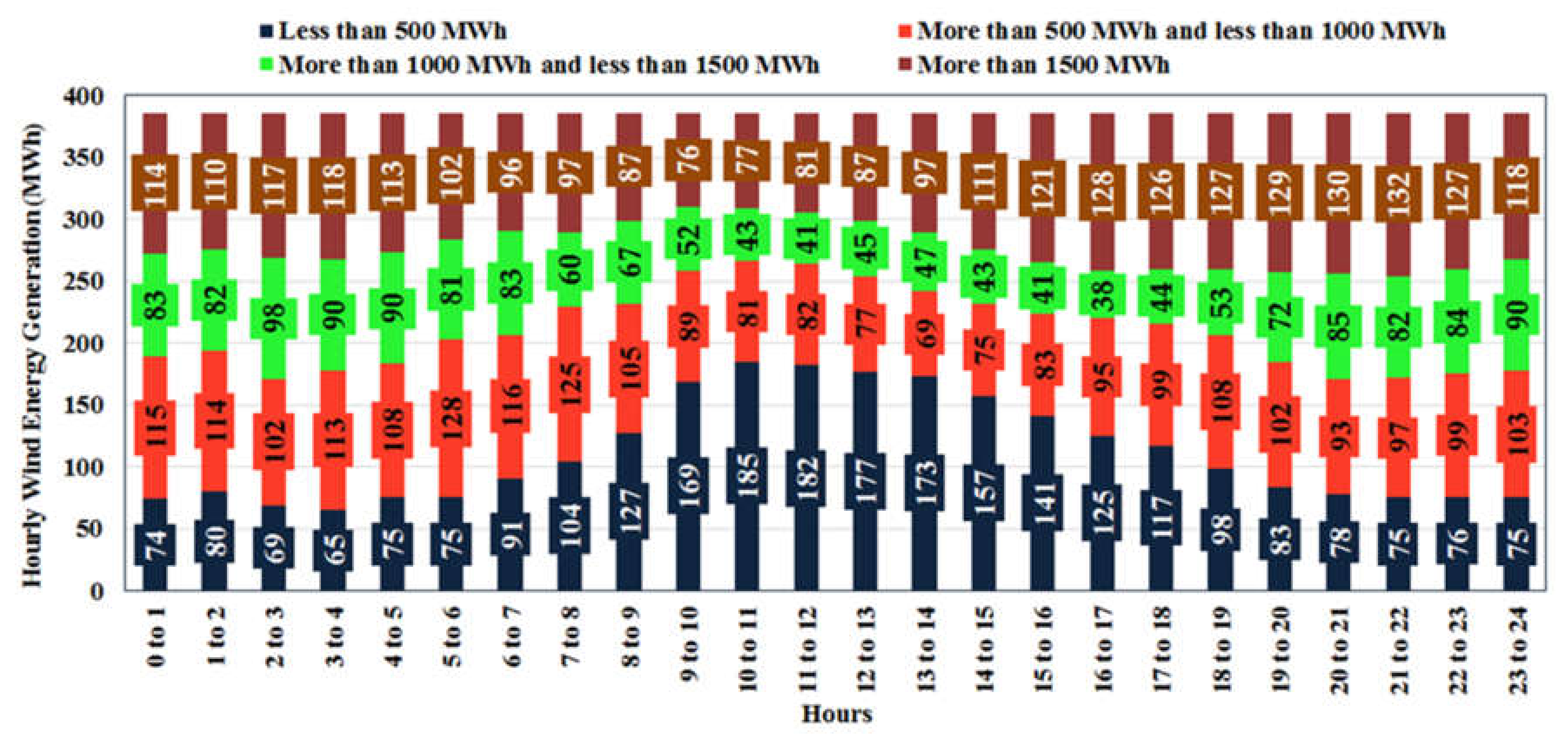
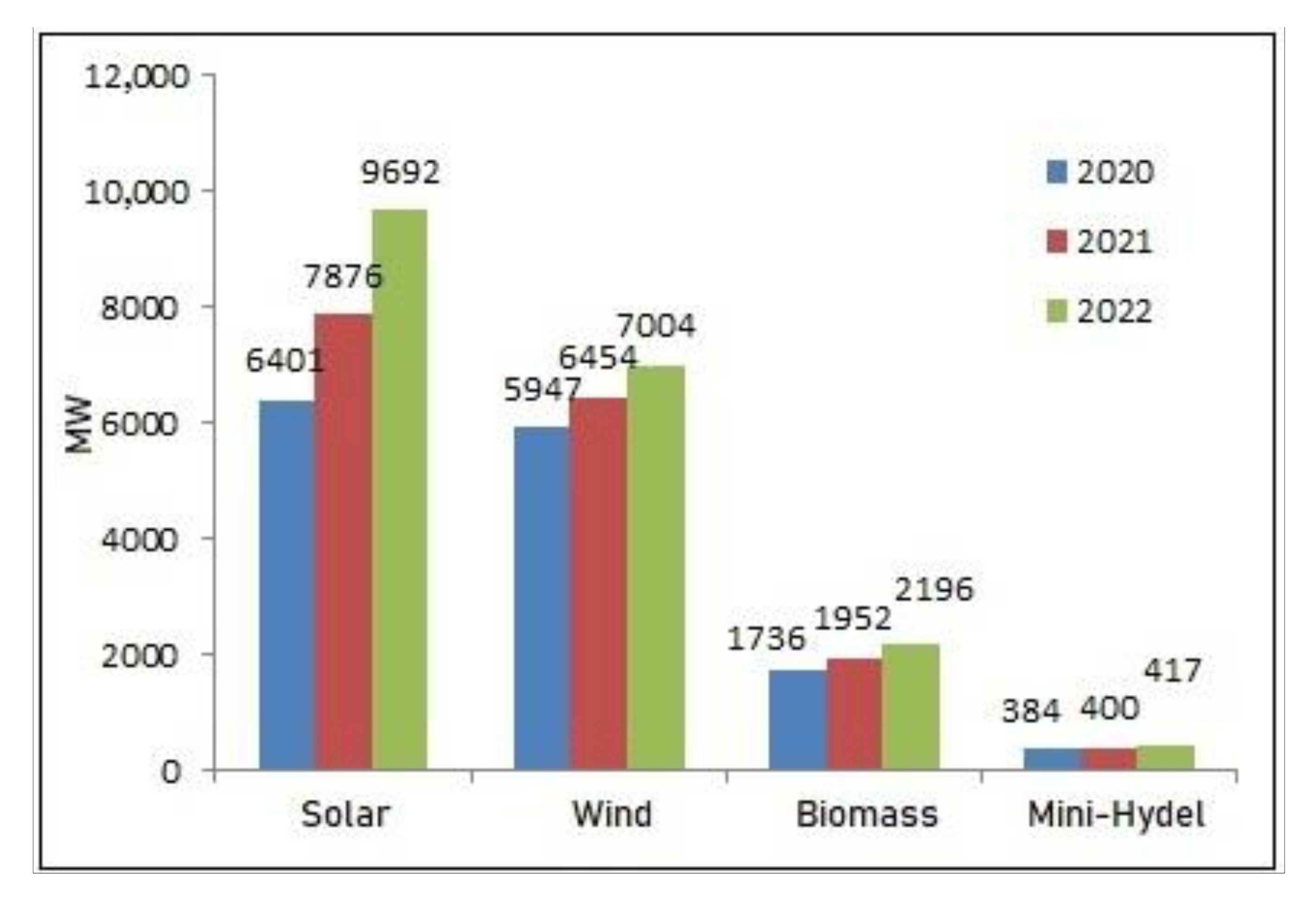
| Sl. No | Solar Park | Approved Capacity (MW) | Location |
|---|---|---|---|
| 1 | Sai Guru (Pragat) | 500 | Bhamer village, Taluka-Sakri, Dhule district |
| 2 | Patoda (Paramount) | 500 | Tambrajuri and Wadsari villages, Talka Patoda, Beed district |
| 3 | Dondaicha | 500 | Vikran and Meti villages, Talka-Dondicha, Dhule district, Maharashtra |
| 4 | Latur | 60 | Sindala Lohara, Taluka-Ausa, Latur district |
| 5 | Washim | 170 | Babhulgaon (20 MW), Pardi Takmor (30 MW), Saykheda (20 MW), Dudhkheda (60 MW), and Kanzara (40 MW) |
| 6 | Yavatmal | 75 | Mangladevi (25 MW), Pimpri Ijara (25 MW), and Malkhed (25 MW) |
| SI. No | Power Plant | Producer | Location | Capacity (MW) |
|---|---|---|---|---|
| 1 | Brahmanvel wind farm | Parkh Industry | Dhule | 526 |
| 2 | Dhalgaon wind farm | Gade Export | Sangli | 275 |
| 3 | Vankuswade wind park | Suzlon Ltd. | Satra district | 254 |
| 4 | Vaspet | ReNew Power | Vaspet | 144 |
| 5 | Jath | ReNew Power | Jath | 84 |
| 6 | Welturi | ReNew Power | Welturi | 75 |
| Resources | Progress from 2010 to 2020 | Installed Capacity Status | Illustration |
|---|---|---|---|
| Wind energy |
| 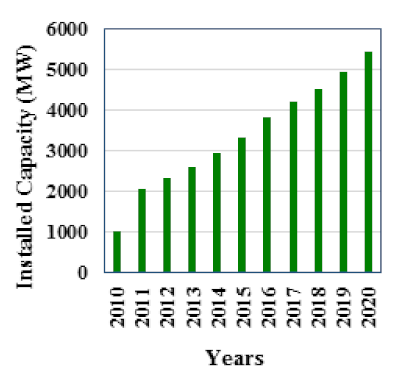 | 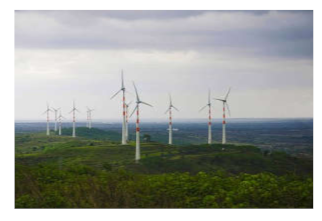 100 MW Chand-Bibi Mahal Wind turbine plant, Ahmednagar |
| Solar energy |
| 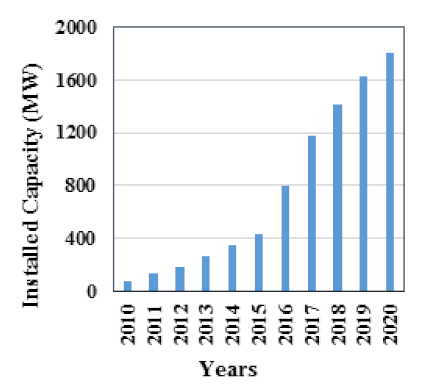 | 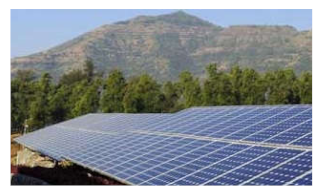 3 MW Tata solar power plant, Mulshi, Male |
| Biomass energy |
| 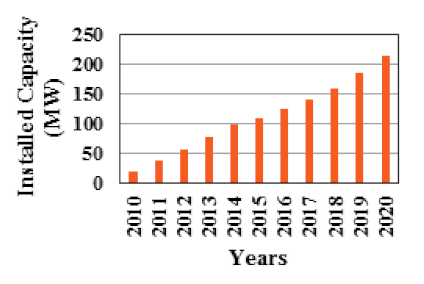 |  10 MW biomass plant, Gadchiroli |
| Small hydropower energy |
| 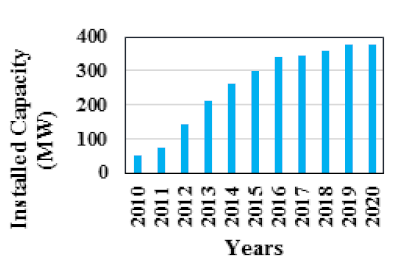 | 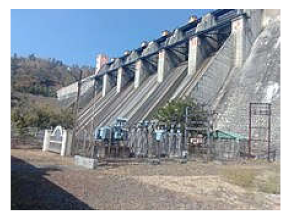 1.5 MW small hydropower plant, Telhara |
| Wave Energy on Maharashtra Coast | |||||
|---|---|---|---|---|---|
| Offshore Avg. Wave Energy kW/m | Coastal Avg. Wave Energy kW/m | ||||
| Site | Annual | (June–August) | Site | Annual | (June–August) |
| Vengurla Rocks | 8.001 | 20.612 | Girye | 5.902 | 14.212 |
| Square Rocks | 6.7901 | 16.643 | Vijaydurg | 5.864 | 13.583 |
| Redi | 6.351 | 16.572 | Ambolgarh | 5.743 | 13.481 |
| Malvan Rocks | 6.910 | 16.731 | Kunkeshwar | 5.642 | 13.352 |
| Kura Inset | 5.793 | 13.745 | Pawa Point | 5.361 | 13.102 |
| Wagapur | 5.701 | 13.101 | |||
| Year | Incentives | Key Features |
|---|---|---|
| 2009 | Endorse solar thermal systems for air-heating/steam-generating applications, solar buildings, and Akshay Urja shops [164]. |
|
| 2012 | Small wind energy and hybrid systems program [165]. |
|
| 2013 | Wind power policy [166]. |
|
| 2014 | Bagasse/agricultural waste-based co-generation power policy [160]. |
|
| 2014 | Small hydropower policy [125]. |
|
| 2015 | Waste to energy policy [167]. |
|
| 2015 | Biomass-based power policy [168]. |
|
| 2015 | Solar power policy [137]. |
|
© 2020 by the authors. Licensee MDPI, Basel, Switzerland. This article is an open access article distributed under the terms and conditions of the Creative Commons Attribution (CC BY) license (http://creativecommons.org/licenses/by/4.0/).
Share and Cite
Madurai Elavarasan, R.; Selvamanohar, L.; Raju, K.; Rajan Vijayaraghavan, R.; Subburaj, R.; Nurunnabi, M.; Khan, I.A.; Afridhis, S.; Hariharan, A.; Pugazhendhi, R.; et al. A Holistic Review of the Present and Future Drivers of the Renewable Energy Mix in Maharashtra, State of India. Sustainability 2020, 12, 6596. https://doi.org/10.3390/su12166596
Madurai Elavarasan R, Selvamanohar L, Raju K, Rajan Vijayaraghavan R, Subburaj R, Nurunnabi M, Khan IA, Afridhis S, Hariharan A, Pugazhendhi R, et al. A Holistic Review of the Present and Future Drivers of the Renewable Energy Mix in Maharashtra, State of India. Sustainability. 2020; 12(16):6596. https://doi.org/10.3390/su12166596
Chicago/Turabian StyleMadurai Elavarasan, Rajvikram, Leoponraj Selvamanohar, Kannadasan Raju, Raghavendra Rajan Vijayaraghavan, Ramkumar Subburaj, Mohammad Nurunnabi, Irfan Ahmad Khan, Syed Afridhis, Akshaya Hariharan, Rishi Pugazhendhi, and et al. 2020. "A Holistic Review of the Present and Future Drivers of the Renewable Energy Mix in Maharashtra, State of India" Sustainability 12, no. 16: 6596. https://doi.org/10.3390/su12166596
APA StyleMadurai Elavarasan, R., Selvamanohar, L., Raju, K., Rajan Vijayaraghavan, R., Subburaj, R., Nurunnabi, M., Khan, I. A., Afridhis, S., Hariharan, A., Pugazhendhi, R., Subramaniam, U., & Das, N. (2020). A Holistic Review of the Present and Future Drivers of the Renewable Energy Mix in Maharashtra, State of India. Sustainability, 12(16), 6596. https://doi.org/10.3390/su12166596










